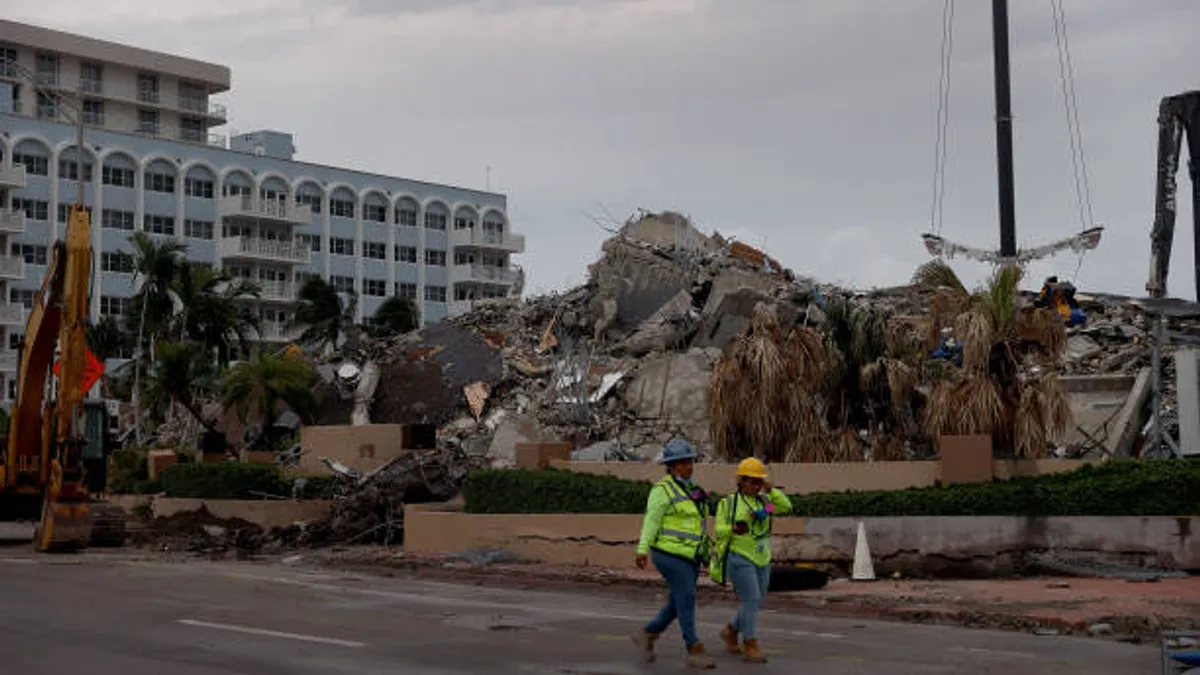As the remaining structure of the collapsed Champlain Towers South in Surfside, Florida, was demolished over the July 4th weekend, construction technology's role in disaster recovery has taken on new importance.
Rescuers on site in Surfside have turned to some high-tech innovations to help them in their search for survivors and remains. The National Institute of Standards and Technology used LiDAR technology to map out the interior of the formerly standing portion of the building prior to its demolition. In addition, drones allowed rescuers to get a bird's-eye view of the collapse and help plan the search, and infrared imaging technology allowed responders to search for signs of life amid the rubble.
One question that remains unanswered is whether robots can be used in disaster scenarios. Many experts say that robots are still not advanced enough to significantly help in rescue operations in an unstructured rubble environment like a building collapse, but a meaningful push by government funding and a more direct focus on research and development could help change that.
One issue is that there is little financial incentive to develop robots like these, said Robin Murphy, Raytheon professor of computer science and engineering at Texas A&M University, who specializes in the field of rescue robotics. Here, Construction Dive speaks with Murphy about how robots can be used in disasters and in construction.
CONSTRUCTION DIVE: Please touch on the challenges in using robots in a rubble environment.
ROBIN MURPHY: First off, just to be clear, robots have been used for disasters for building collapses such as on 9/11, and for the [2017] Berkman Plaza II collapse in Jacksonville, Florida, so they have been around. But the two primary uses of the ground robots are to get into the interior of the rubble to go farther into the narrow voids that you can only put a camera on a stick or borescope into and those are limited to at most 18 feet. And the other is that sometimes you do have parts of the structure still standing. And larger robots can get in without you having to shore up for a human to go back there.
[But an] issue is that robots are still larger than I'd like. They're mostly tract or snake-like robots, and they can't always move. A lot of times you hit a spot where the robot just needs to burrow into the sand to get through to where a void might be, and we don't have robots that burrow yet. And we don’t have robots with eyelids. Robots can function in high heat and fire, but sometimes the sensors can't deal with the dust, smoke or water.
How are these types of robots being developed?
Japan's been working on it for many years. They started out with the standard Olympus borescope camera, 18 feet to 20 feet, pushing on a rope, basically. And they made it into something that vibrates, like a caterpillar. The robot moves forward; it's slow but it works.
One of the problems with any robot working the interior is that [it] might be going between a gap 6 inches wide between two slabs of concrete, but then it suddenly opens up. So a snake-like robot that's using the surface to move itself, all of a sudden, it has no place to go. And so they started adding little gear jacks to help it kind of propel itself over to the next void and steer to the next one. That's an interesting idea.
Outside of disasters, do you see specific use for these robots in a construction scenario?
I think this is one of the things that we'd like to see, most of the robots that are being used for these types of collapses are actually coming from the infrastructure inspection industry, where they're building small robots to go in pipelines, but also to go into cable trays, get back into tunnels that were done where people can't get back into safely. We could also use them to inspect the insides of pylons for bridges. So I think there's a lot of applications.
Are there talks of increasing government funding for robot development projects like this?
There have been talks for 20 years, we really haven't seen that come to practical use yet. This is something that just needs to become part of the standard technical search kit that responders have instead of something seen as "special." The problem is there's no economic incentive to build these types of specialized robots because fortunately, building collapses are very rare. But when they have, they certainly need these tools, and they're feasible, but they just have to get built.
I think the government can, at different levels, explore how to allow responders to get these technologies. They are a little bit expensive. So, they need special grants to be able to buy them. I think there could be much more research and development in these extreme environments.
And I think there's more work to be done on technology transfer, where we use the innovation in the real world. Construction is hard, the construction site isn't the same as somebody's laboratory. It's cold, it's hot, it's rainy, there's dust, there's a lot of noise. So getting that final step, that's again where technology transfer programs can really help accelerate it



















